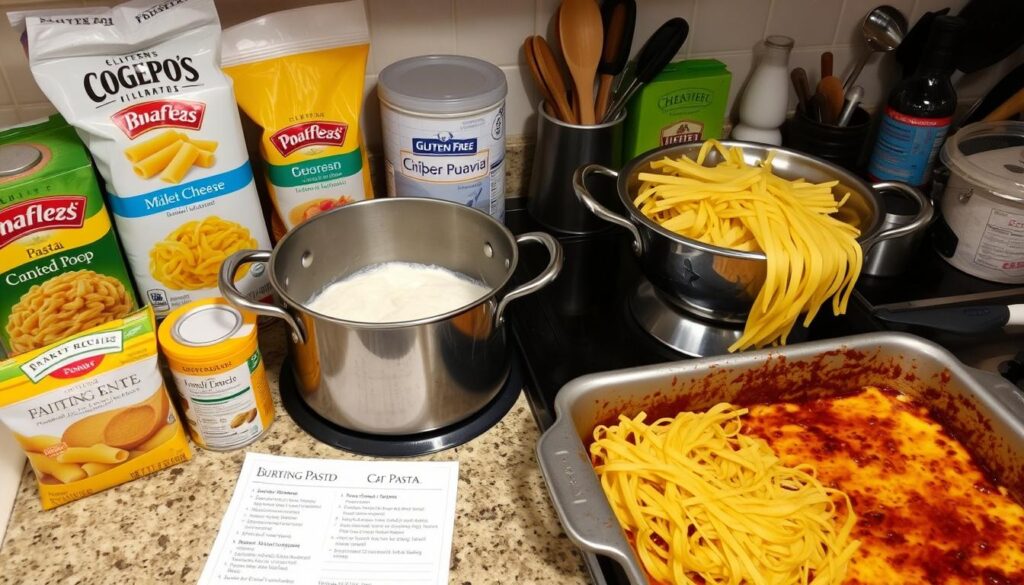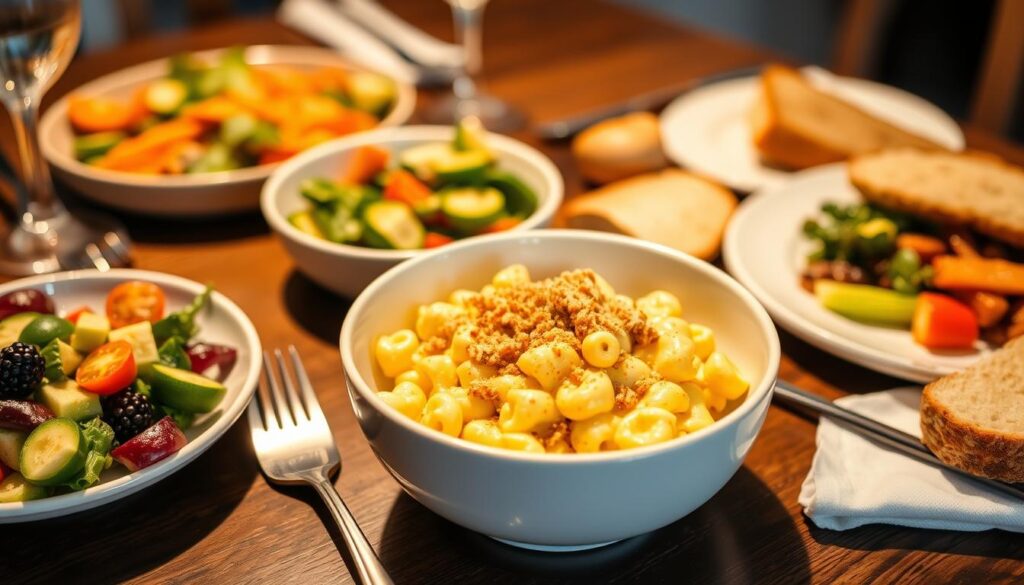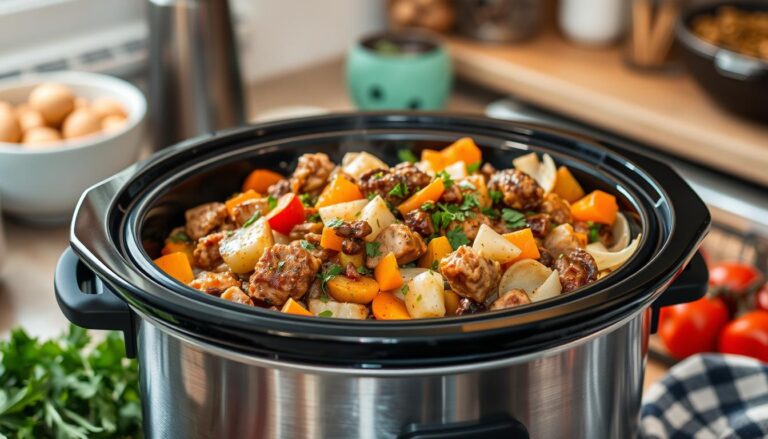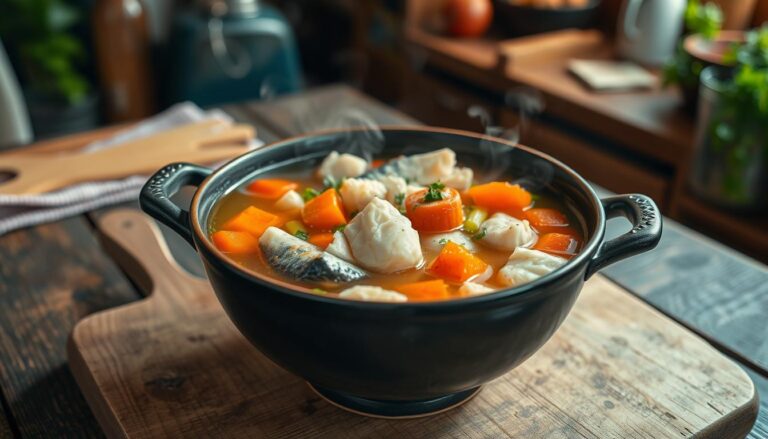The smell of mac and cheese in the kitchen brings back memories. For many, it’s more than food; it’s a warm feeling of home and family. But, for those who follow a gluten-free diet, enjoying this classic dish seemed impossible. Now, there’s a simple gluten-free mac and cheese recipe that’s both easy to make and full of flavor.
Table of Contents
- Gluten Free Mac and Cheese Recipe :
This recipe uses just a few basic ingredients. It’s perfect for busy families and anyone who loves a warm, cheesy dish. Plus, it’s cheaper than store-bought versions. This gluten-free comfort food brings everyone together, proving that everyone can enjoy childhood favorites, no matter their diet.
Key Takeaways
- Easy gluten-free mac and cheese can be made with just 5 simple ingredients.
- This recipe offers a comforting taste reminiscent of the traditional version.
- Homemade gluten-free mac and cheese is more economical than boxed options.
- Leftover mac and cheese can be stored in the refrigerator for 3–4 days.
- Pair this dish with various cheese options like Gouda or Monterey Jack for added flavor.
Introduction to Gluten Free Mac and Cheese
The gluten free mac and cheese recipe is a great choice for a comforting meal without gluten. It uses gluten-free pasta as its main ingredient. You can also use brown rice pasta or a corn and rice blend for a similar feel.
By skipping the traditional flour-based roux, this recipe is both tasty and gluten-free. It meets the needs of those who can’t eat gluten.
What Makes It Gluten Free?
The key to gluten-free comfort food is the pasta. Gluten-free pasta is made from different grains, giving it texture and flavor. Brands offer various blends to suit different tastes.
This way, people with gluten sensitivities can still enjoy their favorite dishes. Making a gluten-free mac and cheese at home can be both healthy and delicious.
Benefits of Choosing Gluten Free
Choosing gluten-free mac and cheese has many advantages. It’s better for those with gluten sensitivity or celiac disease, as it can improve digestion and reduce inflammation.
Using healthy ingredients means you can have a nutritious mac and cheese that’s still full of flavor. Enjoying a classic dish without gluten restrictions is a way to celebrate healthy eating while still enjoying tasty meals.
Essential Ingredients for Gluten Free Mac and Cheese
Starting a gluten free mac and cheese recipe means picking the best ingredients. The pasta, cheese, and milk are key for a creamy texture and rich taste. Knowing these ingredients ensures a dish that’s both tasty and meets dietary needs.
Types of Gluten Free Pasta
Choosing the right pasta is key for gluten-free mac and cheese. Rummo and Barilla offer gluten-free elbows that stay firm. Rummo is especially good because it keeps its shape well.
For four servings, use about 360 grams of gluten-free macaroni pasta.
Cheese Options for Creamy Flavor
The right cheese mix makes the dish creamy and flavorful. Sharp cheddar, American cheese, and cream cheese are perfect. Freshly grated cheese is best to avoid additives that can make the sauce less smooth.
Use about 330 grams of cheese. Mix some into the sauce and save some for topping.
Milk and Cream Choices
Milk is crucial for a creamy sauce. Whole milk or evaporated milk add richness. For dairy-free options, almond or coconut milk work well.
If you want to make mac and cheese without milk, try unsweetened nut milks or other substitutes. They still make the dish comforting.
Step-by-Step Preparation Guide
Making a tasty gluten free mac and cheese recipe needs careful steps. The right cooking methods make it creamy and flavorful. This way, everyone can enjoy it, no matter their diet.
Cooking the Pasta Perfectly
Start by boiling water in a big pot and add a bit of salt for taste. When the water boils, add 1 lb. of gluten-free elbow macaroni. Cook it until it’s al dente, about 8-10 minutes.
Check a piece at the 8-minute mark to avoid mushiness. After draining, rinse the pasta with cold water. This keeps it firm and prevents clumps.
Making the Cheese Sauce
In another saucepan, melt 4 tablespoons of unsalted butter over medium heat. Mix in 1/4 cup of gluten-free flour for 2 minutes to make a roux. Then, slowly add 2 1/2 cups of whole milk, whisking to avoid lumps.
Add 2 teaspoons of gluten-free mustard, 1 1/2 teaspoons of kosher salt, and 3/4 teaspoon of black pepper. This adds flavor. When it thickens, lower the heat and mix in 1 lb. of shredded fontina and 8 oz. of shredded Colby Jack cheese until smooth.
Combine the pasta and cheese sauce, then top with gluten-free breadcrumbs or your choice. Bake under the broiler for 7 minutes for a golden crust. Let it cool for 10 minutes before serving for the best taste and texture. These steps make a delicious gluten-free mac and cheese for everyone.
Tips for the Perfect Creamy Texture
Getting a creamy texture in gluten-free mac and cheese is key. It makes this comfort food even better. Paying attention to how you mix and what ingredients you use is important. This helps avoid lumps and makes the sauce smooth and velvety.
How to Avoid Lumps
To make a smooth cheese sauce, add cheese slowly while stirring. This way, each bit melts into the sauce without lumps. Using fresh cheese instead of pre-shredded helps, as it doesn’t have additives that can mess with the texture.
Turning off the heat after adding cheese helps too. It lets the sauce cool down and get the right consistency.
Choosing the Right Cheese
The type of cheese you pick greatly affects the taste and creaminess. Sharp cheddar adds a strong flavor, while American cheese makes it creamy. Mixing these cheeses can make the dish even better.
Adding fresh cheese, like cream cheese, can also make it richer. Knowing how different cheeses melt and mix is important. It helps in making a delicious mac and cheese.
Flavor Variations to Try
Trying new flavors can make a gluten free mac and cheese recipe even better. Adding vegetables boosts nutrition and makes the dish look great. Changing spices and seasonings can make a simple recipe into a special dish.
Adding Vegetables for Nutrition
Vegetables add health benefits and texture. You can use:
- Broccoli
- Butternut squash (pureed)
- Spinach
- Cauliflower
These veggies make healthy mac and cheese even better. Chefs love adding steamed broccoli or butternut squash puree. They add unique textures to the cheese sauce.
Spices and Seasonings for Extra Flavor
Spices can really boost the taste. Try:
- Paprika for a smoky hint
- Mustard powder for tanginess
- Cayenne pepper for a kick
Adding gluten-free breadcrumbs on top before baking adds a crunchy finish. It makes the dish taste better and look more appealing. Every serving of gluten free mac and cheese will be a hit.
| Vegetable | Benefits | Serving Suggestion |
|---|---|---|
| Broccoli | High in vitamins C and K | Steamed or sautéed |
| Butternut Squash | Rich in beta-carotene | Puree and mix into sauce |
| Spinach | Loaded with iron and antioxidants | Fold in fresh or sautéed |
| Cauliflower | Low in calories, high in fiber | Roasted or steamed |
These ideas let you get creative in the kitchen. A well-seasoned, veggie-packed mac and cheese is more than a meal. It’s a flavor celebration.
Common Mistakes to Avoid
Making gluten-free mac and cheese is fun, but some mistakes can ruin it. Knowing these common errors helps you cook better and enjoy a tastier dish.
Overcooking the Pasta
One big mistake is overcooking gluten-free pasta. This makes it mushy, which isn’t good. It’s key to watch the cooking time to keep the pasta just right. Cook it for about 8-10 minutes, depending on the pasta type. Take it off the heat when it’s al dente.
Using the Wrong Cheese
Choosing the right cheese is important for creamy, tasty gluten-free comfort food. Stay away from cheeses that don’t melt well or have additives. Use high-quality, fresh cheese for the best results. Cheddar, Gruyère, and mozzarella are great for a smooth, tasty sauce.

| Mistake | Description | Solution |
|---|---|---|
| Overcooking the Pasta | Leads to mushy texture. | Cook al dente, about 8-10 minutes. |
| Using the Wrong Cheese | Can cause poor sauce consistency. | Opt for high-quality, freshly grated cheese. |
| Skipping Salt in Pasta Water | Results in bland flavor. | Add salt to enhance the pasta’s taste. |
| Baking at Incorrect Temperature | May lead to uneven cooking. | Preheat oven to 400°F for optimal baking. |
| Inadequate Cheese-Sauce Ratio | Can affect creaminess. | Maintain a balanced cheese-to-pasta ratio. |
Avoiding these mistakes can make your gluten-free mac and cheese better. It becomes a dish that’s perfect for any time.
Storing and Reheating Leftovers
Leftover gluten free mac and cheese can be a delightful treat if stored and reheated properly. Using best practices makes it enjoyable even after the first serving. Knowing how to store and reheat keeps the flavor and texture just right.
Best Practices for Refrigeration
To keep the gluten free mac and cheese tasting great, store leftovers in an airtight container. This stops moisture loss and keeps odors away. A sealed container keeps the mac and cheese fresh for 3-5 days, so you can enjoy every bite.
How to Reheat Without Loss of Quality
Adding a splash of milk can make the mac and cheese creamy again. For microwaving, heat in short bursts and stir between each one to avoid drying. Reheating on the stovetop gives you more control over the texture and consistency.
| Storage Method | Duration |
|---|---|
| Airtight Container (Refrigerated) | 3-5 Days |
| Microwave Reheat | Short Intervals, Stirring Often |
| Stovetop Reheat | Add Splash of Milk, Heat Gently |
By following these tips, each serving of leftover gluten free mac and cheese stays enjoyable. It keeps its place as a favorite comfort food.
Serving Suggestions
Gluten-free mac and cheese can be more than just a meal. Serving it with the right dishes can make it special. Adding complementary foods not only boosts flavor but also nutrition. It’s easy to make a meal that’s both tasty and healthy.
Perfect Pairings with Gluten Free Mac and Cheese
For a complete meal, try these pairings:
- Grilled Chicken – It’s a lean protein that goes well with creamy pasta.
- Roasted Vegetables – They add crunch and vitamins, like asparagus or bell peppers.
- Fresh Salad – A light arugula salad with lemon vinaigrette can make the dish pop.
Creative Ways to Serve
How you present gluten-free mac and cheese can make it more appealing. Here are some ideas:
- Individual Servings – Serve in ramekins for a fancy look.
- Toppings – Try homemade gluten-free breadcrumbs or fresh herbs for a crunchy finish.
- Elevated Ingredients – Add gourmet proteins like bacon or lobster for a fancy twist.

Using these ideas can make gluten-free mac and cheese a highlight of any meal. Combining easy recipes with thoughtful pairings ensures a satisfying and nourishing dining experience for all.
Conclusion and Final Thoughts on This Recipe
This easy gluten free mac and cheese recipe is more than just a meal. It lets you customize it to your liking. You can pick from cheeses like cheddar, Colby, or Pecorino Romano. This makes it perfect for different tastes and diets.
Adding dried red pepper flakes gives it a spicy kick. Or, you can add veggies for more nutrition. This recipe is fun and easy to make.
This gluten free mac and cheese is great for busy nights. It’s quick to make, ready in just 30 minutes. It’s also good for kids, making it a hit with everyone.
Don’t forget to enjoy the leftovers. They keep well in the fridge for up to five days or in the freezer for three months. This recipe is a fun way to make delicious meals for everyone, no matter their diet.
FAQ
Is gluten-free mac and cheese really just as tasty as the traditional version?
What types of gluten-free pasta can I use in this recipe?
Can I make this mac and cheese dairy-free as well?
How can I make my mac and cheese healthier?
What is the best way to prevent clumpy cheese sauce?
How should leftovers be stored and reheated?
Can gluten-free mac and cheese be served as a main dish?
What types of cheese work best for gluten-free mac and cheese?
How do I achieve the ideal texture when cooking gluten-free pasta?
Are there any good toppings to enhance gluten-free mac and cheese?
Source Links
- https://www.glutenfreepalate.com/easy-gluten-free-macaroni-and-cheese/
- https://thereislifeafterwheat.com/2024/04/gluten-free-mac-and-cheese-recipe/
- https://iowagirleats.com/one-pot-gluten-free-mac-and-cheese/
- https://cookingkatielady.com/recipe/cottage-cheese-mac-cheese-gluten-free-high-protein/
- https://therealfooddietitians.com/dairy-free-mac-and-cheese/
- https://glutenfreeonashoestring.com/gluten-free-mac-and-cheese/
- https://www.mygfguide.com/gluten-free-mac-and-cheese-recipe/
- https://www.mamagourmand.com/gluten-free-mac-and-cheese/
- https://www.southernliving.com/gluten-free-mac-and-cheese-7965355?srsltid=AfmBOopS6zL6BPQpR0enGmNVRkPdExQUQLVY1lvJiLhos4c0evfhTxp1
- https://wiser.eco/gluten-free-mac-and-cheese/
- https://allergyawesomeness.com/gluten-free-mac-and-cheese/
- https://www.passmesometasty.com/gluten-free-mac-and-cheese/
- https://www.southernliving.com/gluten-free-mac-and-cheese-7965355?srsltid=AfmBOopToTjoFPj2tYFxjxXJ01qQnZjtqLjtsowrYNUnQEFCU5ToHfAq
- https://www.peelwithzeal.com/baked-gluten-free-mac-and-cheese/
- https://www.tasteofhome.com/recipes/gluten-free-mac-and-cheese/?srsltid=AfmBOoqmUS7eCSmTn2O-gHIO_oEL2mISeSh5J5AYWYal3b5e0wWqqER3
- https://foodess.com/old-fashioned-baked-macaroni-and-cheese-extra-creamy/
- https://thesaltycooker.com/gluten-and-lactose-free-baked-macaroni-and-cheese/
- https://teatimewithnaomi.com/cafeteria-macaroni-and-cheese/
- https://www.southernliving.com/gluten-free-mac-and-cheese-7965355?srsltid=AfmBOoqJtfGScaG7b7CPbhtg1bFJHqj-wzyaBKFz7IGkMq7oqhPhL64m
- https://wheatbythewayside.com/gluten-free-macaroni-and-cheese-stovetop-or-baked/
- https://www.southernliving.com/gluten-free-mac-and-cheese-7965355?srsltid=AfmBOop_aCEFRCcO2AHlSmT6l8Avwlq6HuCEJ1iJT1rba1Lq1jpygCtG
- https://www.aboutamom.com/gluten-free-mac-and-cheese/
- https://www.idratherbeachef.com/cauliflower-mac-and-cheese/
- https://www.simplystacie.net/easy-macaroni-cheese/






